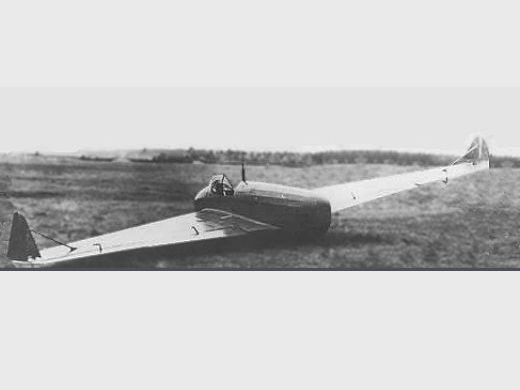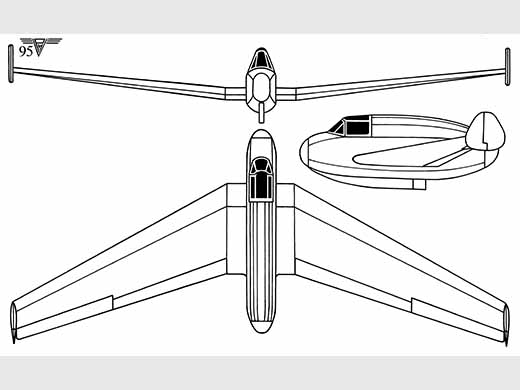
Kayaba Ku-2
Autre nom (ou nom en langue originelle) : Kimura Ku-2 (萱场 2 型无尾翼滑翔机)| DONNÉES GÉNÉRALES |
| Année du premier vol (ou de design, si seul projet) |
1940 |
| Pays | Japon |
| Designer(s) | KIMURA, Hidemasa |
| Premier constructeur | Kayaba Industry (JP) |
| Type d'appareil | Aile volante |
| Fonction | Expérimental |
| SPÉCIFICATIONS TECHNIQUES |
| Envergure | 9.8 m |
| Longueur | 3.04 m |
| Hauteur | -- |
| Allongement | -- |
| Surface alaire | 14.5 m2 |
| Profil aile | -- |
| Masse à vide | 124 kg |
| Masse maxi | -- |
| Charge alaire | -- |
| Vitesse mini | -- |
| Vitesse maxi | 75 km/h |
| Finesse maxi | |
| Taux de chute mini | -- |
| Nb sièges | 1 |
| Structure | -- |
AUTRES INFORMATIONS
| Constructeur(s) |
| ||||||
| Infos techniques | -- | ||||||
| Histoire résumée | The Kayaba gliders were developed to investigate the characteristics of tailless aircraft, and other than a 1938 private venture, the HK-1, were sponsored by the Japanese Army. The HK-1 was designed by Dr. Hidemasa Kimura based on an idea by pioneer aviator Kumazo Hino, the first person to fly an airplane in Japan, in 1910. Tests with the HK-1 led to Army interest, and Dr. Kimura, later to become Professor of the Science and Engineering Department, Nippon University, during the post-war years, responded with the KU-2. Working with Kayaba's Chief Designer Shigeki Naito, Kimura designed a single-seat model that flew 270 flights between October 1940 and May 1941. Working closely with Kayaba’s Chief Developing Designer, Dr. Shigeki Naito, Kimura designed and constructed a tailless test model aircraft. The model, designated the KU2, was extensively tested between early November 1940 and May 1941. After the test phase of the KU2 was over, Dr. Kimura, with the assistance of another brilliant Japanese engineer, Joji Washimi, began to work on a more advance design in the spring of 1941, the KU3. The Kayaba Ku-2 (萱場 2型無尾翼滑空機) was a glider built in Japan in 1940 to investigate the possibilities of tailless aircraft.[1] It was developed as part of an Imperial Japanese Army contract that had been offered to designer Hidemasa Kimura following the successful flights of his HK-1 tailless glider over the previous years. Developed with the help of the Kayaba Industry's chief designer Shigeki Naito, the Ku-2 had a swept wing with two vertical fins at the end of the wings. The Ku-2 flew 262 test flights between October 1940 and May 1941 before being damaged beyond repair in a crash. | ||||||
| Liens personnalités | Pas de personnalité associée. | ||||||
| Compléments docs |
SOURCES DOCUMENTAIRES
| Liens WEB | Site : 100 Jahre Nurflügel /A century of flying wings . Kayaba Ku-2. (2009-10-28 JM) Site : Aviation Models . Japan's World War II Flying Wing. Texte + photo. (2018-10-07 CL) Site : Century of Flight . Japanese flying wings, par E.T. Wooldridge (note + photo). (2011-01-01 CL) Site : The Aviation History Museum on Line . Japan's Flying Wings by Raul Colon (note + photo). (2011-01-01 CL) Site : [Knowfar Strategic and Defense Studies Institute] . Note + 1 photo + specs. (2011-01-24 CL) Site : Nuricom (Klaus Niegratschka) . Plan 3 vues. (2011-04-13 CL) |
| Livres | Pas de livre référencé. |
| Autres sources | Wooldridge, E. T.; National Air and Space Museum (1983). Winged wonders: the story of the flying wings. Washington, DC: Smithsonian Institution Press. p. 85. ISBN 978-0874749663. |

Team J2mcL © 2003 -
- Pages optimisées pour Mozilla Firefox

